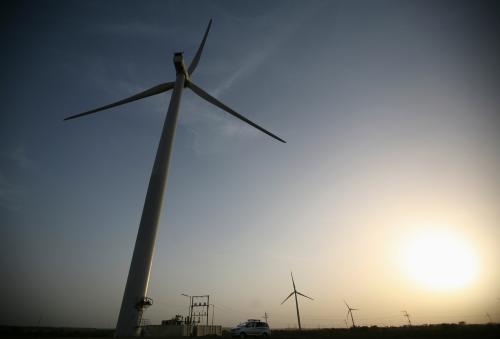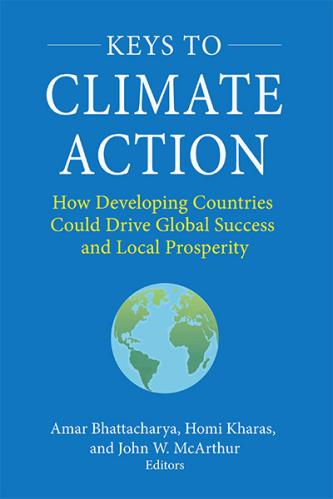Content from the Brookings Institution India Center is now archived. After seven years of an impactful partnership, as of September 11, 2020, Brookings India is now the Centre for Social and Economic Progress, an independent public policy institution based in India.
At least one newspaper headline this year declared that renewable energy in India is now cheaper than coal and that coal is surely on its way out. However, recent research from my Brookings colleague Samantha Gross and me shows that the transition will not be nearly as smooth as some imagine. Renewable energy will be increasingly important in India, but cannot entirely displace coal in the short run.
India’s energy strategy is important for any global discussion about lowering carbon emissions. Most current plans focus on the low-hanging fruit of “cheap renewable energy.” However, scaling renewable energy even further—towards deep decarbonization of India’s energy system—is a much harder task, and will require a host of technical, policy, and regulatory improvements.
India’s ambitious plans
Even before COP21 in Paris, India announced a very ambitious renewable target: installing 175 gigawatts (GW) of renewable capacity by 2022, a quadrupling of renewable energy capacity in just seven years. India’s motivations for this ambitious target are varied: It is seeking global leadership in combating climate change, energy security, drawing more (and newer) sources of capital, and simply more electricity at lower prices.
How has India done? Remarkably well in absolute terms. Solar makes up the lion’s share of the capacity target, at 100 GW. In 2017, India added almost 10 GW of solar, the second-highest capacity addition in the world (although far behind China’s 53 GW). Nevertheless, India has not added capacity fast enough to keep pace with its target.
Grid-scale solar generation now draws more investment than new coal plants. Although observers cite lack of financing as a limitation, it is unlikely to be the fundamental bottleneck. Counterparty risk from India’s mostly insolvent utilities is the biggest challenge. Consumer-owned “rooftop” solar installation is way behind its 40 GW target, with only about 2.5 GW of capacity installed. This isn’t for lack of roofs or sunshine—instead rooftop solar threatens to deprive local utilities of their best customers, and the utilities thus resist such deployments.
India has used bidding to draw out fierce competition and lower solar and wind prices, down to 2.44 Indian rupees per kilowatt-hour (kWh) (about 3.5 U.S. cents per kWh). But these prices cannot be compared directly to those for fossil fuel generation, since renewable energy is not “dispatchable”—it is available only when the sun shines or the wind blows.
“Too much” capacity?
For decades, India’s electricity system suffered from power shortfalls. However, in the last few years that problem has decreased, due to changes in both demand and supply.
Electricity demand is now growing at a slower rate than gross domestic product (GDP). The increasing share of the services sector of the economy contributed to slower demand growth, as did rising energy efficiency. The remarkable government bulk procurement program for LED bulbs reduced their costs by an order of magnitude in just a few years and distributed hundreds of millions of efficient bulbs.
On the supply side, coal-fired power capacity grew dramatically, at 12.7 percent compound annual growth rate from fiscal year 2011 to fiscal year 2017, double the growth of demand for electricity, leaving India with more than sufficient generation capacity. This surplus of coal-fired capacity makes it difficult for states to build new renewable generation to meet the targets, since they have to pay for the coal plants they have already built. Additionally, solar energy is not available to meet peak electricity demand, which is mostly in the evening.
Renewable energy is not explicitly subsidized to lighten the cost burden. However, in many cases renewable energy receives implicit subsidies for land and the system-level costs that renewable energy creates are socialized across other generators. The Central Electricity Authority estimates that these costs could be as high as 1.5 Rupees/kWh (over 2 US cents/kWh) for some states today.
Deep Decarbonizing
“Deep decarbonization” is a nebulous term, but it generally means extensive reductions in carbon emissions, exceeding current government targets. India’s 2022 targets are impressive, but don’t change the global story. Can India continue or accelerate its renewable energy plans?
The good news: India will meet the goals it set forth in its Nationally Determined Contribution under the Paris Agreement even if it is somewhat delayed in reaching its 2022 renewable energy target.
The bad news: Renewable energy is only inexpensive when it can be readily absorbed into the grid when it is available. When the share of renewable energy is much larger, the intermittent nature of wind and solar energy becomes a greater challenge. At this point, a more advanced grid and technologies to store electricity become very important. However, storage technologies are not economically viable today.
If India aims for deeper decarbonization over time, policymakers need to think beyond renewable energy supply. A few policy rethinks include:
- Better frameworks for electricity—Variability is the hallmark of renewable energy, requiring a flexible grid in technical and contractual terms. Pricing that recognizes the time of day when power is supplied would be a great first step. Today, only about 3 percent of power is purchased through power exchanges that reflect supply and demand conditions, the rest is purchased through power purchase agreements that treat all power the same, regardless of its variability.
- Smart(er) Grids—Smart grids are more than just smart meters. The future grid will allow demand to react to variable renewable energy supply. When solar generation creates surplus power in the middle of the day, load must shift to such time periods. For example, load from agricultural pump-sets can be easily shifted in time, but other loads may require more significant efforts.
- Energy Efficiency—If carbon reduction (or saving money) is the goal, energy efficiency needs more attention and funding. Unlike capital investments in generation, there is no regulated rate of return for efficiency investments. Buildings pose an incentives challenge. New buildings will be part of the capital stock for decades, but builders often care little about the occupants’ energy costs. The housing sector is also complex and plagued with corruption. Although regulations on paper sound good, enforcement is a major gap.
- Co-benefits—Cleaner energy is welcome, but market penetration of cleaner technologies, including electric vehicles, will accelerate when they provide additional benefits, including energy security, employment, and reduction in local air pollution. Unfortunately, many of these co-benefits aren’t recognized or internalized in planning processes at the central, state, or municipal levels.
- Global support—An influx of global capital would increase funding and lower interest rates. India needs more than transfer of current renewable energy technology—it also needs innovative regulation and business models. Global lessons learned can help.
India should be lauded for its efforts at becoming greener, despite the development pressure it faces. However, there are limits to how fast India can decarbonize and even heroic efforts in India will not be enough to the change the global emissions trajectory. But every step helps, especially India-sized steps. India and the world need to be aware of the financial and political challenges as they plan an energy transition beyond just adding more solar panels.








Commentary
Understanding India, its energy needs and ambitions, and the global implications for carbon emissions
September 18, 2018